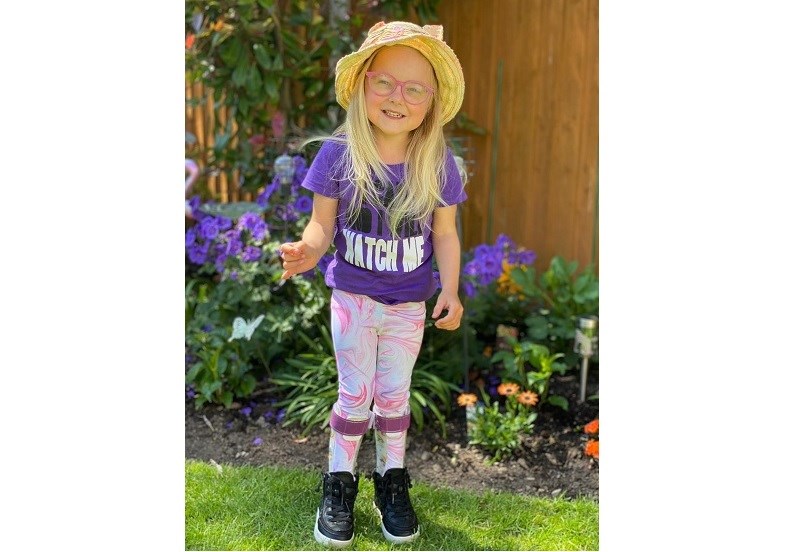
07 March 2022
After a two year hiatus due to Covid, LOC was delighted to be able to re-open its clinic in the Brian Blatchford building at Salford University on Valentine’s Day.
The first patient to benefit from the facilities was Sofia, a five-year-old with cerebral palsy. Her parents were originally told that she was unlikely to be able to walk independently. Sofia has been under the care of John Turner, one of our senior orthotists, since September 2020. She underwent SDR surgery in December 2021.
LOC is very experienced in the rehabilitation of children following this groundbreaking surgery. For Sofia’s fitting appointment for a new pair of AFOs, John was joined by Sam Walmsley director of LOC, who was keen to show off what the University’s Gait Laboratory could do for Sofia. The Laboratory provides quantitative gait analysis for four NHS trusts in the Manchester area and LOC is delighted to have access to these state-of-the-art facilities.
In Sofia’s words (in reality Clare, her mum’s words):
John commented: “Following her surgery, Sofia has been working really hard on her walking with help from her parents. We now had the opportunity to check out how she was progressing using the Gait Lab facilities at Salford University.
Sofia enjoyed the whole experience and walked over the force plates consistently, so we were able to use the resulting diagnostics immediately to fine-tune Sofia’s new splints. We also changed the heels of her shoes to make her walking action smoother and more comfortable.
We will now see Sofia every few months to check things are still working well as she grows, to make sure she stays tall and balanced with her walking.”
If your child has Cerebral Palsy or any other neurological condition, they could benefit from the advice of LOC team of experienced clinicians who also have the advantage of access to our Gait Lab facilities in Kingston and Salford. Click here for a free initial video consultation.
LOC’s clinic is based in the University of Salford’s Podiatry Department and provides treatments for orthotics, scoliosis, pectus deformities, positional plagiocephaly and club foot.
It is also the base for LOC’s northern OSKAR clinic which is run by Sam Walmsley, clinical director of LOC, in conjunction with Elaine Owen MBE MSc SRP MCSP.
Clothing worn is dependent on which clinic you are attending. You will be sent a letter detailing what clothing to wear along with all other details prior to any appointment at the clinic.
This depends on several factors; the position of the chest wall deformity, its severity, the flexibility of the chest, the kind of results wanting to be achieved and the age of the person undergoing treatment for pectus excavatum or pectus carinatum.
Early adolescence (roughly between the ages of 12-16 years old) – is an optimum age to start treatment, given that the chest is still maturing, and flexible, permanent correction is more easily achievable. Once bracing treatment is complete and a patient has stopped growing, the deformity will not return. For younger pectus patients, conservative bracing is used to keep a deformity from worsening and can help them to avoid surgery in later life.
For older pectus patients (between the ages of 20 to 30) results can be harder to achieve, as the costal cartilage hardens into the bone as a person matures. Over the years we have successfully treated many adults for both pectus excavatum and pectus carinatum and active adults with flexible chests can expect good results.
Again, this hugely depends on what a patient wants to achieve from treatment; whether that’s avoidance of surgery, improvement in the appearance of the chest shape, reduction in rib flaring etc. All these goals are taken into consideration during your first consultation. While there are no serious health risks of having pectus carinatum or excavatum – beyond the cosmetic – for many patients and parents, treatment outcomes involve improving confidence and self-esteem. During our 2018 Pectus Patient Survey, 92% of pectus carinatum patients surveyed said that treatment had a ‘major improvement’ or ‘an improvement’ on their social life.
You can read the results of our 2018 Pectus Patient Survey and quality of life questionnaire here.
If you are worried about your chest shape, or your child’s chest shape, then get in touch for a free Skype consultation with one of our pectus specialists who can assess their chest and discuss treatment options. We are always happy to communicate with local GPs, thoracic surgeons and consultants if a patient approaches us for bracing treatment after considering other options.